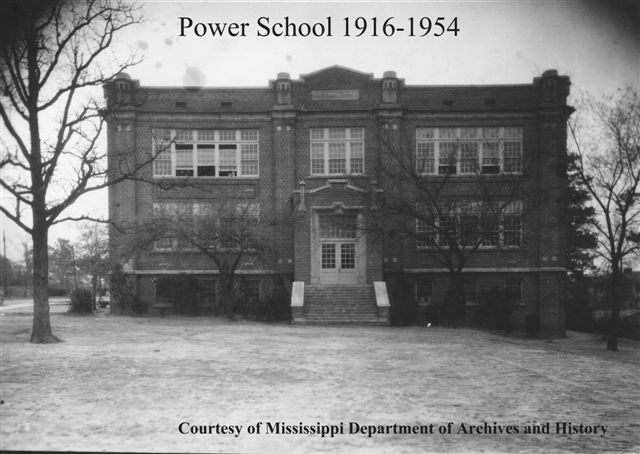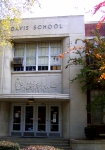Blair Cross
Justice Peace Equality
Two Trees
Rose Singer
Urban Mermaid
Cool Sun
The Sun King
Sunday Morning in Smith Park
The Powers That Be
Many in our neighborhood know Power School as the modern APAC facility at Riverside and Peachtree Streets, winner of major national awards and a proud educational exponent of excellence in the arts. But there was an old Power School as well, now a church parking lot, but instrumental in the early education of a number of Jackson’s finest citizens.
Old Power (1916-54)

The original Power School was named for John Logan Power (1834-1901). According to board minutes for August 21, 1916, two resolutions of definite importance were passed. The first concerned the election of Mr. Edward Bailey as Jackson Public School superintendent and a subsequent resolution named the “new elementary school for Col. J.L. Power.” (1) While not a “school man”, per se, Col. Power served on several boards and committees which provided administration to Jackson’s early school system. A native of Tipperary, Ireland, he came to the United States when he was 16-years-old. In 1862, he entered the Confederate Army as a sergeant in the 1st Artillery Regiment, Company A. He served in the Vicksburg Campaign and was a prisoner of war until pardoned in July of 1863. In 1864, he was made superintendent of army records, with the rank of colonel. Col. Power was in the publishing business prior to the Civil War, being owner and publisher of the Jackson Daily News which he purchased in 1860. He subsequently helped establish the Mississippi Standard, which was later (1866) merged into the Clarion. In 1887, he and R.H. Henry of Brookhaven consolidated their two papers, the Jackson Clarion and the Brookhaven Ledger, into the Clarion-Ledger. In 1896, he sold his interest in the paper to become Secretary of State. He was re-elected in 1899 and served in this capacity until his death in 1901. For 27 years, Col. Power was superintendent of the First Presbyterian Sunday School and was a ruling elder in that church. He was Grand Secretary of all Mississippi Masons from 1869 until his death. (1) (2)
The first Power School was built in 1916 with an entrance facing North State Street on its southeast corner. The original entrance is shown on the Mississippi Department of Archives and History photo at the end of this article. Several years later, the school was expanded eastward and the main entrance faced Pinehurst Street across from what is now First Presbyterian Church. Land for the school was acquired from J.T. Harper (11/17/15), W. Carnahan (2/11/16) and F.L. Mayes (10/29/15). The two-story brick schoolhouse, designed by N.W. Overstreet and Hays Towns, was completed and ready for business by the fall of 1916. (3) (5) According to an article in the August 27, 1916, Jackson Daily News, “Attention is called to the fact that the Col. J.L. Power School, which is now in process of construction, will be open by the first school day in September.” Classes actually began on September 18, 1916. The article goes on to state, “The final touches will be added in a week and the building will be in good shape for occupancy. Every new and up-to-date device, appliance, convenience and sanitary condition has been provided for the children who will, beginning with the coming session, begin school here. “ The Board of Education wishes to call attention to the fact that boundary lines have been established with regard to this new school and they will be strictly enforced. The boundary lines (are) defined as follows: “On the south, the Power School will be bounded by Fortification Street, except those children who live on Fortification Street, west of State Street. These will continue to attend the Davis School. The (Power) school is bounded on the west by the Illinois Central Railroad tracks and on the north and on the east by the city limits.” (10)

Old Power was situated on the north end of town. Gillespie Street and east-west streets running southward into downtown Jackson were fairly well developed as shown by residences in the 1916 Jackson City directory. There were a few homes on the west side of North State (Canton Road) but most land areas were open fields and meadows. Pinehurst Street was largely undeveloped. (4) The 1946 Sanborn Fire Insurance map indicates Power as facing north. It was a red brick structure with a east and west wing. The building had electricity and was heated by a gas furnace. “Air conditioning” was furnished by open windows. The main entrance was at 709 Pinehurst Street but there were also entrances off North State on the west and a basement entrance facing east. (5) Architecturally, it was built along the lines of other early Jackson grade schools, e.g., Davis, Galloway, Poindexter, George, Lee, (Jim) Hill and Smith-Robinson. The original school building contained five classrooms. The school’s first teachers were first grade, Miss Emma Green; second and third grade, Miss Mabel Bridges; fourth grade, Miss Ruth Reed; fifth and sixth grade, Miss Jim Hailey; and seventh grade, Miss Marcia Gibbs, who was also served as the school’s first principal. (10) (1)
Several former students at old Power remember the structure well. Mrs. Charlotte Charles, Judge Swan Yerger and Mr. Muller Addkison were contemporary students at Power in the late 1930’s and early 1940’s. Mrs. Charles lives in her three generation family home on Gillespie Street. Mr. Addkison lives in his family home on Gillespie Street and Judge Yerger is retired and a resident of northeast Jackson, although he spent much of his boyhood on Poplar. (7) (6) (8) Mrs. Charles remembers Power as follows. “The first floor contained grades 1-3 separated by a large center hall. There was the cafeteria on the south side and two cloakrooms. The second floor contained grades 4-6, an auditorium, adjacent library and the principal’s office. Bathrooms were in the basement.” She remembers the black slate blackboards and the rows of desks bolted to the floor. Desks were wooden with tops that raised over a space for books and supplies. The west yard facing State Street contained wooden swings, see-saws, rings for swinging and a hand propelled merry-go-round. There was also an open lot where the younger kids played their games and occasionally baseball. “We were caught up in the war effort (WWII) as children,” Mrs. Charles said. “We planted a Victory Garden during the war and filled Red Cross boxes to send overseas to troops. Although the cafeteria served good food, some of the neighborhood children, including myself, came home for lunch each day.” (7)
All three of these early Power students were synchronous. All remember the same teachers from their years in the late 1930’s and early 1940’s. According to all, first grades were taught by Miss Minnie Hill and Miss Emma Green; second grade by Miss Mary McLemore and Miss Alfreda Misterfeldt; Third grade, Miss Hattie Casey and Miss May Fulmer; fourth grade, Miss Elaine Mack and Miss Ellisine Butler; fifth grade, Miss Frances Parnell and Miss Marguerite Briscoe; and sixth grade, Mrs. Gray Hillsman and Miss Elizabeth Williamson. The principal was Mr. R.B. Layton (10) Miss Briscoe became principal upon the reassignment of Mr. Layton to Bailey Junior High in 1942, and continued in that role through the closure of old Power in 1954 and until her own retirement in 1960 at the new Power on Riverside Drive. She was replaced in her fifth grade classroom by Miss Nancy Parks. (1) (6) (7) (8)
Jackson oilman and republican philanthropist Billy Mounger remembers one earlier teacher. “I remember a Miss Miazza, my fourth grade teacher, who was good looking”. She became a ‘Mrs.’ Later in the year.” (9) Judge Swan Yerger is most complimentary of his teachers. “These ladies were dedicated to their profession and took great personal interest in their students. They were good examples to follow.” (6) Good behavior was necessary for learning in Power’s early years. According to Judge Yerger, “Miss Green had an enclosed dunce corner similar to a child’s room in her classroom but I don’t remember anyone being sent there. Excessive talking could get you sent to the hall in front of the classroom or you could be sent to the cloakroom.” Miss Green handed out rewards as well as corrections. She would send little slips of paper home with the well-behaved children on which was written the word “good” or other positive comments . Miss McLemore would use a ruler to maintain order. “She would ask a boy to hold out his hand for a mild slap to remind him to mind his teacher.” (6)

Judge Yerger remembers the classroom layouts and entrances on three sides of the building. “There was an auditorium on the second floor,” he said, “with a stage and folding seats. The east side of the building was mostly grass where the primary playground was located. “There was a ‘jungle jim’ see-saws and a slide. The west side was infrequently used and the northside was, of course, the main entrance. There was an alley behind the east yard where kids would ride their bikes and park them in racks located inside the basement door. Some children would be dropped off at the school by their parents in the morning and we would walk home, sometimes stopping by a friend’s house on the way. Children from further away would ride the bus.” Walking and biking were primary means of transportation back when old Power was new. Only a few households could afford the new 1916 Dodge Brothers automobile or its companion the Maxwell. Remember Jack Benny? Judge Yerger remembers an open field across from the school on Pinehurst where the older boys would play softball during recess and after school on a diamond laid out for that purpose. First Presbyterian Church, constructed in 1950, stands on the old sandlot today.
One of Judge Yerger’s many memories of Power was being selected as a Safety Patrol captain in the sixth grade. As a Patrol Boy he helped children cross the busy streets around the school and worked with Sgt. Allen, a Jackson PD motorcycle safety policeman. “Of course there were fewer cars then,” he said. The judge proudly attests “I still have my badge.” Judge Yerger has graduated so let’s be careful when crossing North State. (6) Mr. Addkison remembers a number of his contemporaries from the halls of old Power. Some of these were James Boyd Campbell, Martha Harris, later to become Mrs. Campbell; Frances Heidelberg Coker, Wesley Ann Travis, Bob Travis, James Elliott, Catherine Swaze, Mary Ann McNeil, Martha Henderson, Libby Mounger, Fred Sanders, B.B. McLendon, Shannon Williford. There were also Dennis Brown, Billy Cook, Bobby Davat, David DeCell, Anne Foy, Ronnie Horowitz, Barkie Johnston, Jane Laird, Billie Mahaffey, Bob Merryman, Betty Small, Bobbie Thrower, Dot Tingle, Olive Caldwell, Natalie Chance, Betty Eckles, Jack Flood, Billy Fulgham, Pete Hand, Ralph Hester, Bryant Horne, Chester Jones, Boyne Oxford, George Reed, Billy Riecken, Dolly Ann Shortridge, Claude Smith, Lois Smith, Ernest Spencer, Jimmy Stout, Haskell Turner, Victor Vance, Frances Ann Beecham and Virginia Cavett. (8)
All of Power’s students were not as conventional as Charlotte, Swan and Muller. Billy Mounger began his schooldays at Power in its final kindergarten session in 1931. Author of the book Amidst the Fray (2006), he shares his own experiences at Power School.
“I was an individualist,” Mr. Mounger attests. “I remember when Miss Green would give out the ‘good’ cards. Jane Best got one everyday, but I never got one.” Young Billy relates how he got “run over” when he was in kindergarten. “I came out of kindergarten one day and realized I had missed my ride. There was a crossing policeman at North State but I decided to cut across the Millsaps campus to where we lived at the time. A lady in a Model A Ford ran over me on State Street. She broke my leg, knocked out some teeth and sent me to the Baptist Hospital. I had a cast on my leg for weeks but I have forgiven her.” Mr. Mounger related some of his experiences and impressions at Power to “just being me.” “We didn’t have much playground,” he recalls. “We had to improvise on the lot across the (Pinehurst) street and find things to do during recess in or near the main building. We could also listen to the World Series in the auditorium. One of the things I do remember is that while the building was not that old it was structurally unsound. It was held together with iron rods with stars on each end.” Young Billy made a discovery in his fifth grade class. School administrators had recently changed the grading system from A,B,C, etc. to VS (very satisfactory), S (satisfactory), N (normal) and U (unsatisfactory). The new ratings compared the current student achievement with that of the previous term. “I would take my report card home with a ‘satisfactory’. “My father would be upset because it would appear I wasn’t making progress. I was being compared to my former status not an advancement and hence could do no better. Dad would say, ‘why you’re just normal. You can do better than that’.”

Students were placed in 1930’s Power according to a “tracking method”. “I sat in the third grade with 28 girls and 13 boys,” Mr. Mounger said. “It took a while for me to realize I was in with the ‘higher’ students. Girls must have been smarter than boys in those days – or more motivated.” Regardless of early behavior, leadership comes out in many forms. “Individualist” Billy Mounger was made a captain of the school’s Safety Patrol in the sixth grade. “I got demoted from the captain’s role for kicking a door in the classroom, almost hitting the principal. This even carried over to my high school days. I am probably the only West Point graduate to get kicked out of Junior R.O.T.C. at Central.” Some of Billy Mounger’s friends at Power were Mrs. Homer (Jane) Best, Dr. Harold Caver, Doris Allen Jones of Bryant Galleries, Eddie Guillot, “Boots” Watkins, who headed up the first electrical engineering company in the state; Dickie Deaver who became a scientist, future oral surgeon Sam Sanders and Polly Wells who was selected most beautiful both at Central High and Ole Miss. (9) While “prominent” is a matter of individual taste, all four early Power students were the sons and daughters of pre-war Jackson citizens who grew up in a time of structure, sacrifice and personal responsibility. “We respected our teachers,” Mr. Mounger said, “We considered them on the same level as doctors and always invited them to our events.” Jackson was better for the time these youngsters spent at Power School and the families who sent them there.
Public transportation consisted of city buses which deposited kids at the school corner where crossing guards like Swan Yerger and Billy Mounger helped them across busy streets. Many students walked from home or rode their bicycles. You bought a meal ticket for $1 a week and ate in Mrs. Henrietta Yerger Lewis’ or later Mrs. Margaret Lloyd’s cafeteria. Mr. Mounger remembered Mrs. Lewis, the mother of his friend Van Lewis, as the cafeteria manager when he was at Power. “Those who did not have a dollar for a ticket were provided one by the state. They could also bring lunch from home and eat in the cafeteria with their friends.” Young Billy Mounger remembers well when a single lunch meal cost anywhere from a dime to fifteen cents. “We lived over on Keener Street near the Mississippi Children’s Home when I was at Power. This was before the family moved to St. Ann in Belhaven. My father, who did not make money at the time, would give me ten cents each day for lunch. The fifteen cent lunch included milk and a dessert. My father also would not let me go to school barefooted in warm weather saying he did not want people to think his children had no shoes. Some of my classmates who lived in Belhaven at the time did come to school barefooted and I was jealous of their independence.” (9)
The co-author of this article was an individualist also and a first grader at Power in 1945-46. I’ll tell you a little story about Billy Harvey and old Power School. As mentioned, it was a small building compared to today’s schools as Jackson was a much smaller (and more settled) place. Elementary schools back then were true neighborhood fixtures drawing their students and much of their faculty from well defined areas in the vicinity of their homes. There have always been degrees of learning ability although this fact today is either ignored or blamed on society. In short, some students were smarter than others or had a better learning foundation at home. Unfortunately, all pupils were seated in the same classrooms – even special ed students who were described as “slow”. There was no provision in Mississippi, other than military schools such as Chamberlain-Hunt academy, for “problem” youth. As previously mentioned, I was an individualist.

I lived on Manship Street which was in the Power School district. Davis School was on the other side of Fortification. When I was five years old, a debilitating illness prevented my starting in the first grade with my contemporaries. I was sent to the Preventorium in Magee to recover. I did not have TB, but this was a state run facility for all types of youth who had to rehab from a serious illness. While at the Preventorium we were given instruction at the grade level analogous with our chronological age. We had the same readers as the Jackson Public Schools so we still had Dick and Jane but they were read in Simpson County. When I returned to Jackson and my family, my mother, a third grade teacher, was hell bent and determined I would not fall behind. Consequently, she taught me reading, simple math, spelling and basic grammar at a higher level than first grade. Mothers want to be proud of their off-spring, want them to say smart things and if you don’t watch them, will unintentionally encourage their little treasures to be show-offs. Alas.
When I was able to attend public school I was placed in Power. Billy Harvey would be classified today as ADD or some similar type nervous disorder. Then (1946), I was considered to have the heebie jeebies, was an unruly child in spite of corporal discipline at home and spent much time in the hall outside the classroom. One of my tricks after getting “sent to the hall” for putting live grasshoppers in Mrs. Covington’s desk was to go down to the basement and hide. There I would watch old Henry, the janitor, stoke the furnace and he would let me know when Miss Briscoe was looking for me. “Henry,” she would call down the downstairs hall, “Have you seen Billy Harvey?” “No’m,” Henry would lie as I hid under the stairs. Henry and I shared a lot of conversation down in the furnace room, mostly about Miss Briscoe and after a while I would re-emerge saying I had been in the bathroom all that time and wanted to get back to my desk. By then Mrs. Covington, a Godly woman, had forgiven me and Miss Briscoe was none the wiser. I was good until the next time. I have to say after all these years that Henry was my friend. I bribed him with $.18 tins of Prince Albert Tobacco to inform me of impending danger and will have a tin of it ready as soon as I see him in heaven. After that, we are going to look for Miss Briscoe.
Old Power School’s day was done. Yazoo clay, structural problems and a rapidly growing Jackson community had taken their toll on Belhaven’s premier elementary school. First Presbyterian Church needed the land. The neighborhood was attracting many new families. It was time to move on to a new and larger building and in 1954 the school closed, to reopen at 1120 Riverside Drive. And what doors it opened!
Bill and Nan Harvey October 2013

Nan Ertle Harvey is a native of Yazoo County, a graduate of Mississippi College and has lived with her husband Bill in the Belhaven neighborhood since 1994. She worked in a research position in the Department of Microbiology at UMMC, retiring in 2003. Nan’s hobbies are photography, nature study and family research. She is a volunteer at the Mississippi Department of Archives and History. Bill Harvey is a native Jacksonian, living most of his life in Belhaven. A MSU Bulldog, he has had careers in journalism, education and as development director of the Andrew Jackson Council, Boy Scouts of America. Bill enjoys photography, music, writing articles for neighborhood sources and sharing experiences with friends at a local coffee shop. (Text copyright Bill and Nan Harvey, used by permission of Bill and Nan Harvey.)
Sources & Acknowledgements:
1. A History of the Public Schools in Jackson, Mississippi (1832-1972), William
Moore Dalehite, Board of Trustees, Jackson Public Schools, 1974, pp. 138-39;
291-92
2. Publications of the Mississippi Historical Society, edited by Franklin L. Riley,
secretary, Vol. III; Oxford, Mississippi, printed for the Society, 1900, p. 73
Courtesy of the Mississippi department of Archives and History (2013)
3. Story of Jackson, William D. McCain, Vol. I, J.F. Hyer Publishing Company,
Jackson, MS 1953, P.250
4. Jackson City Directory (1916)
5. Sanborn fire Insurance Company maps (1925,1946)
6. Telephone conversations with Judge Swan Yerger (10-03-13) (10-17-13)
7. Interview with Mrs. Charlotte Charles (09-27-13)
8. Interviews with H. Muller Addkison (10-08-13) (10-24-13)
9. Interview with William D. Mounger (10-11-13)
10. Jackson Daily News , Sunday, August 27, 1916, page 5
Special thanks to Mrs. Nancy Smylie, assistant to Dr. Marlynn Martin, Power APAC School for background information on the history of the school and her personal appreciation of its mission; Mrs. Charlotte Charles, Judge Swan Yerger, Mr. H. Muller Addkison and Mr. William D. Mounger for sharing their personal experiences at Power back in the day; Dr. Jean (Sister) Simmons for her extensive contributions to Power APAC School and for leading discussions on both the old and new schools; The Mississippi Department of Archives and History for the photo of the original Power School; A History of the Public Schools in Mississippi (1832-1972), William M. Dalehite 1974 (p. 13), for photo of John Logan Power; and Old Henry, to whom I shall always be grateful.









